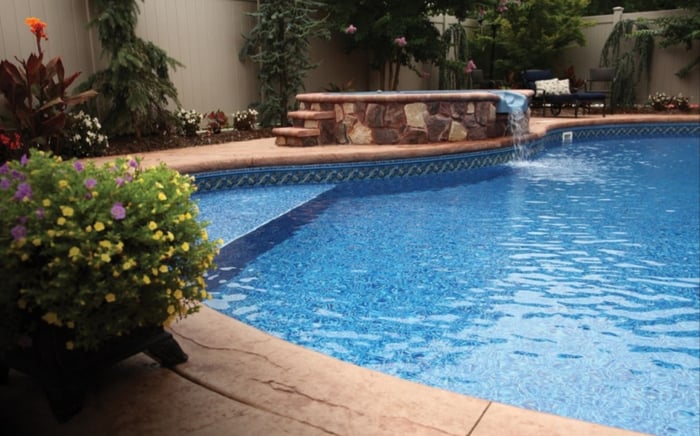Opening Inground Pools: Steps and Costs
Opening your inground pool correctly is crucial to ensuring a safe and enjoyable swimming season. Not only does this process prepare the pool for use, but it also helps prevent costly damage to your pool equipment and surfaces. By following the right steps, you can extend the life of your pool and ensure that it’s in top condition for your family and friends.
Find out more about How to Open Your Swimming Pool.
Opening Inground Pools Preparations
Before diving into the steps of opening your inground pool, it’s essential to prepare adequately. Here’s what you need to do:
- Gather Necessary Tools and Supplies: Start by collecting all the tools and supplies you’ll need. This includes a pool cover pump (if water has accumulated on the cover), a skimmer net, garden hose, pool chemicals (like chlorine and algaecide), a water test kit, and any equipment you stored over the winter such as ladders, handrails, and skimmer baskets.
- Inspect the Pool Area: Before starting, inspect the pool area for any visible damage. Check the pool cover for tears or heavy debris, and make sure there are no cracks or wear on the deck or surrounding areas.
- Remove Standing Water and Debris: If there is standing water on your pool cover, use a pool cover pump to remove it. Clear away leaves, branches, and other debris with a soft broom or pool brush to avoid any contaminants falling into the pool when you remove the cover.
- Check Pool Equipment: Ensure all your pool equipment is in good condition. Reattach any components you removed during the winter, like the pump, filter, and heaters, and inspect them for any signs of wear or leaks. Lubricate o-rings and gaskets as needed to prevent issues when you start up the system.
Steps to Open an Inground Pool
A Step-by-Step Guide to Removing & Storing the Pool Cover
- Use a Pool Cover Pump: Begin by using a pool cover pump to remove any water that has accumulated on the cover. This prevents dirty water from spilling into the pool when the cover is removed.
- Clear Off Debris: Use a skimmer net or leaf blower to remove leaves, twigs, and other debris from the cover. Removing this debris now will make it easier to handle the cover and prevent anything from falling into the pool.
- Carefully Remove the Cover: Enlist help if needed to carefully pull the cover off the pool. Start by removing the anchors or weights, then fold the cover inward as you pull it off to avoid dragging debris into the water. Make sure to do this slowly and evenly to prevent damage to the cover or the pool’s edges.
- Clean the Cover: Once the cover is removed, lay it out flat on a soft surface. Clean it using a pool cover cleaner or a mild detergent with water.
- Dry and Store the Cover: Allow the cover to dry completely before folding it. This prevents mold and mildew during storage. Store the cover in a cool, dry place, preferably in a sealed container to protect it from pests and moisture.
Reconnecting & Inspecting Pool Equipment
- Reconnect the Pool Pump, Filter, and Heater: Start by reconnecting your pool equipment, including the pump, filter, and heater. Make sure all connections are tight and secure. If you used any winterizing plugs, remove them and replace them with the appropriate fittings.
- Inspect the Pump: Check the pool pump for cracks, wear on the seals, or any other visible damage. Ensure that the pump is free from any obstructions and that it primes correctly when turned on.
- Check the Filter: Whether you have a sand, cartridge, or DE filter, inspect it for damage or excessive buildup. Clean or replace filter media as necessary. A properly functioning filter is crucial for maintaining clean and clear water.
- Ensure the Heater is Ready: Examine the pool heater for any debris, corrosion, or blockages. Make sure the valves are set correctly, and if the heater uses a pilot light, check that it ignites properly.
- Test for Leaks and Unusual Noises: Once everything is reconnected, turn on the pump and filter system. Listen for any unusual noises and inspect all equipment for leaks.
Cleaning and Vacuuming the Pool Floor
- Remove Floating Debris: Before deep cleaning, use a skimmer net to remove any floating debris such as leaves or insects from the water's surface. This step prevents clogging the vacuum system during the next stage.
- Brush the Pool Walls and Floor: Use a pool brush to scrub the walls and floor of the pool. This loosens any dirt or algae that may have accumulated during the winter months. Pay special attention to areas around the steps and other tight corners.
- Set Up the Vacuum System: Attach the vacuum head to a telescopic pole and connect the hose to your skimmer or dedicated vacuum port. Prime the vacuum hose by filling it with water to remove air, then connect it to the pool’s pump system.
- Vacuum the Pool Floor: Slowly vacuum the pool floor, moving in overlapping lines to ensure thorough cleaning. This helps remove settled debris and dirt, leaving your pool floor clean and ready for swimming.
- Empty the Skimmer and Pump Baskets: After vacuuming, empty the skimmer basket and the pump strainer basket of any collected debris. This helps maintain proper water flow and prevents clogging.
Learn the essentials of How to Clean and Maintain Your Swimming Pool.
Balancing The Pool Water Chemistry
| Factor | Ideal Range | Adjustment Type |
| pH | 7.2 - 7.6 | Use pH increaser or decreaser to maintain balance |
| Alkalinity | 80 - 120 ppm | Add alkalinity increaser if below range, or a pH reducer if above range. |
| Chlorine | 1.0 - 3.0 ppm | Use chlorine tablets or granules to adjust levels as needed. |
| Calcium Hardness | 200 - 400 ppm | Add calcium increaser if levels are low, or dilute with water if too high. |
| Cyanuric Acid | 30 - 50 ppm | Add stabilizer to protect chlorine from sunlight, ensuring proper sanitation. |
Discover more Swimming Pool Chemical Balancing Tips.
Thorough Inspection of Plumbing and Fixtures
After reconnecting your pool equipment, it’s vital to thoroughly inspect the plumbing and fixtures. Look for any signs of leaks, such as damp areas around the pipes or air bubbles in the water, which could indicate a crack. Check all seals, gaskets, and fittings for wear or damage, and replace them as necessary. Additionally, examine the pool lights, ladders, and handrails to ensure they are secure and free of corrosion.
Gradual Re-introduction of Pool Chemicals and Water Circulation
- Start with Chlorine: Begin the chemical reintroduction process by adding a small dose of chlorine. This initial sanitization helps to kill any lingering bacteria or algae that may have developed during the off-season. Be sure to add the chlorine gradually to avoid overshooting the required level.
- Add Other Pool Chemicals Gradually: Following the manufacturer’s instructions, slowly add other necessary chemicals such as pH adjusters, algaecide, and stabilizers. Adding these chemicals gradually helps prevent imbalances and allows you to monitor the water chemistry more effectively.
- Activate the Pool Pump: Turn on the pool pump to begin circulating the water. Proper circulation is crucial as it helps distribute the chemicals evenly throughout the pool, ensuring that all areas receive adequate treatment.
- Run the Pump Continuously: Allow the pump to run continuously for at least 24 hours. This ensures thorough mixing of the chemicals and filtration of the water. After this period, test the water chemistry to check if the chemical levels are within the recommended ranges.
- Adjust Chemical Levels as Needed: Based on the water test results, make any necessary adjustments to the chemical levels. Ensure that the chlorine, pH, and alkalinity are all within safe and recommended ranges before allowing anyone to swim.
How To Open an Inground Pool with Sand Filter
- Reattach the Multiport Valve: Begin by securely reattaching the multiport valve to the sand filter. This valve controls the flow of water through the different filter settings, so it’s crucial that it’s properly connected to avoid leaks or improper filtration.
- Connect the Pump and Return Lines: Next, connect the pump and return lines to the filter. Make sure all connections are tight and that the hoses are in good condition with no cracks or wear. Open the necessary valves to allow water to flow from the pump into the filter and then back to the pool.
- Set the Multiport Valve to the “Filter” Position: With everything connected, turn the multiport valve to the “Filter” position. This is the standard setting for regular filtration. Prime the pump by filling it with water if necessary to ensure it starts correctly.
- Backwash the Filter: Backwashing is essential for cleaning out any debris or buildup that accumulated during the previous season. Set the multiport valve to the “Backwash” position and run the pump for 2-3 minutes or until the water in the sight glass is clear. This process reverses the flow of water through the filter, flushing out impurities.
- Return the Valve to the “Filter” Position: After backwashing, set the valve back to the “Filter” position. Run the pump to check that everything is functioning correctly and that water is circulating properly. Monitor the pressure gauge to ensure it’s within the normal operating range, indicating that the system is clean and running efficiently.
Discover What do the settings on my Sand Filter do?
How Much Does It Cost To Open an Inground Pool
| Service Type | DIY Cost Estimate | Professional Service Estimate |
| Basic Pool Opening | $50 - $200 | $250 - $400 |
| Pool Cover Removal | $50 - $100 | Included in service |
| Chemical Balancing | $50 - $150 | Included in service |
| Equipment Inspection | Free (self-check) | $100 - $200 |
| Total Estimate | $150 - $600 | $250 - $500+ |
How To Open an Inground Pool - Frequently Asked Questions
- How do I properly close my inground pool?
Closing your pool involves cleaning, balancing the water chemistry, adding a winterizing kit, and securely covering the pool to protect it during the off-season. - What pitfalls should I avoid when opening my inground pool?
Avoid skipping steps like equipment inspection or water balancing, as these can lead to costly repairs and unsafe swimming conditions. - What are some signs my pool equipment might need fixing or replacing?
Unusual noises, leaks, or a drop in water pressure can indicate that your pool equipment needs attention. - How soon can I swim after adding pool chemicals?
You should wait at least 24-48 hours after adding chemicals, once levels are within the recommended ranges. - Why is regular maintenance of my inground pool important?
Regular maintenance ensures your pool stays safe, clean, and enjoyable, and helps to prevent costly repairs. - What services do pool opening services typically provide?
Professional services often include cover removal, equipment reinstallation, chemical balancing, and a thorough inspection of the pool and its equipment.










